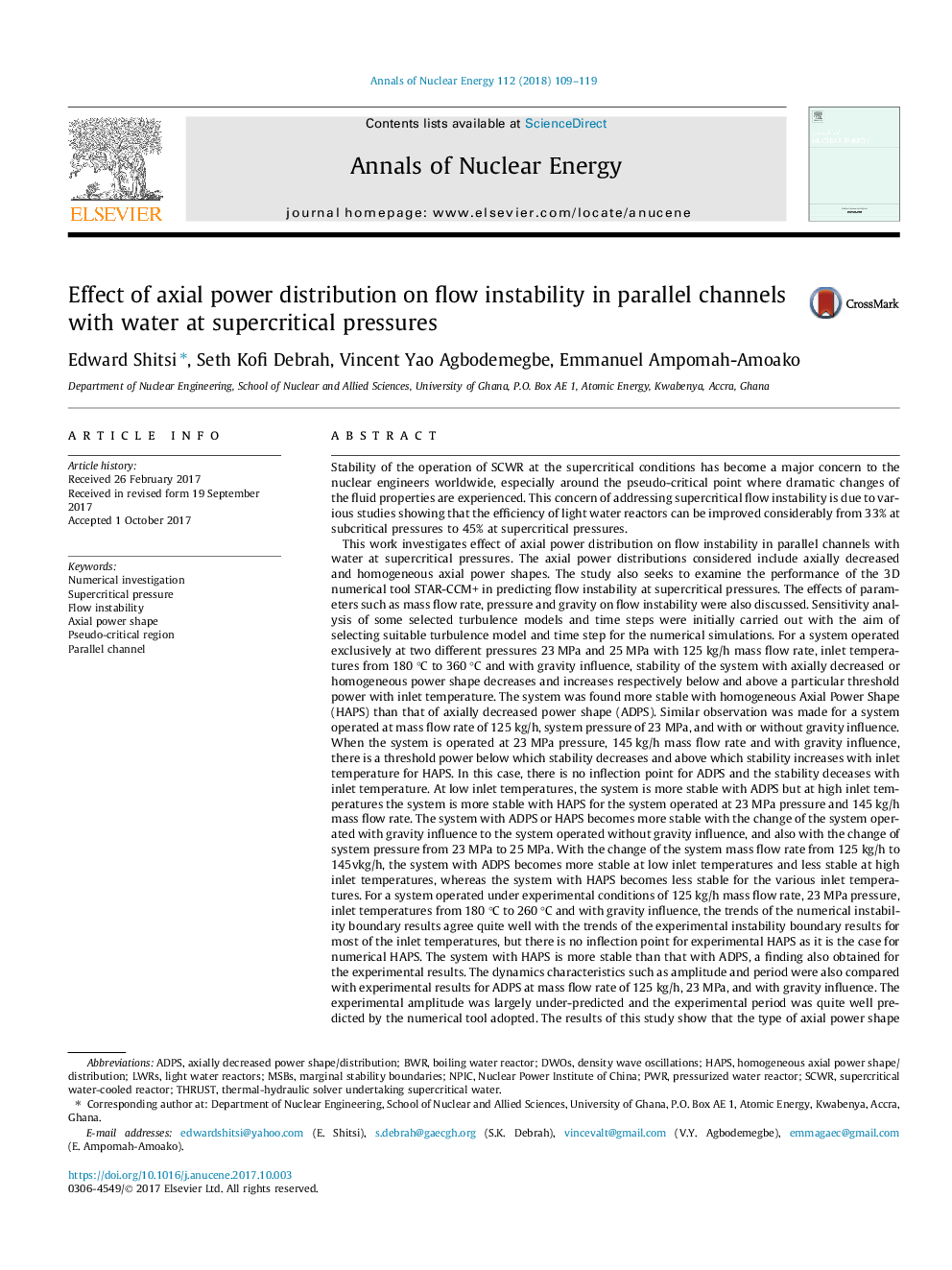| کد مقاله | کد نشریه | سال انتشار | مقاله انگلیسی | نسخه تمام متن |
|---|---|---|---|---|
| 5474753 | 1521084 | 2018 | 11 صفحه PDF | دانلود رایگان |
- Supercritical flow instability in parallel channels is investigated.
- Analysis of flow dynamics characteristics and instability boundaries.
- Mass flow rate, pressure, and gravity significance on flow instability.
- Type of axial power shape adopted significance on stability of the system.
- Validated Numerical results with experimental results.
Stability of the operation of SCWR at the supercritical conditions has become a major concern to the nuclear engineers worldwide, especially around the pseudo-critical point where dramatic changes of the fluid properties are experienced. This concern of addressing supercritical flow instability is due to various studies showing that the efficiency of light water reactors can be improved considerably from 33% at subcritical pressures to 45% at supercritical pressures.This work investigates effect of axial power distribution on flow instability in parallel channels with water at supercritical pressures. The axial power distributions considered include axially decreased and homogeneous axial power shapes. The study also seeks to examine the performance of the 3D numerical tool STAR-CCM+ in predicting flow instability at supercritical pressures. The effects of parameters such as mass flow rate, pressure and gravity on flow instability were also discussed. Sensitivity analysis of some selected turbulence models and time steps were initially carried out with the aim of selecting suitable turbulence model and time step for the numerical simulations. For a system operated exclusively at two different pressures 23â¯MPa and 25â¯MPa with 125â¯kg/h mass flow rate, inlet temperatures from 180â¯Â°C to 360â¯Â°C and with gravity influence, stability of the system with axially decreased or homogeneous power shape decreases and increases respectively below and above a particular threshold power with inlet temperature. The system was found more stable with homogeneous Axial Power Shape (HAPS) than that of axially decreased power shape (ADPS). Similar observation was made for a system operated at mass flow rate of 125â¯kg/h, system pressure of 23â¯MPa, and with or without gravity influence. When the system is operated at 23â¯MPa pressure, 145â¯kg/h mass flow rate and with gravity influence, there is a threshold power below which stability decreases and above which stability increases with inlet temperature for HAPS. In this case, there is no inflection point for ADPS and the stability deceases with inlet temperature. At low inlet temperatures, the system is more stable with ADPS but at high inlet temperatures the system is more stable with HAPS for the system operated at 23â¯MPa pressure and 145â¯kg/h mass flow rate. The system with ADPS or HAPS becomes more stable with the change of the system operated with gravity influence to the system operated without gravity influence, and also with the change of system pressure from 23â¯MPa to 25â¯MPa. With the change of the system mass flow rate from 125â¯kg/h to 145vkg/h, the system with ADPS becomes more stable at low inlet temperatures and less stable at high inlet temperatures, whereas the system with HAPS becomes less stable for the various inlet temperatures. For a system operated under experimental conditions of 125â¯kg/h mass flow rate, 23â¯MPa pressure, inlet temperatures from 180â¯Â°C to 260â¯Â°C and with gravity influence, the trends of the numerical instability boundary results agree quite well with the trends of the experimental instability boundary results for most of the inlet temperatures, but there is no inflection point for experimental HAPS as it is the case for numerical HAPS. The system with HAPS is more stable than that with ADPS, a finding also obtained for the experimental results. The dynamics characteristics such as amplitude and period were also compared with experimental results for ADPS at mass flow rate of 125â¯kg/h, 23â¯MPa, and with gravity influence. The experimental amplitude was largely under-predicted and the experimental period was quite well predicted by the numerical tool adopted. The results of this study show that the type of axial power shape adopted in supplying heat to the fluid flowing through heat transfer system has significant effect on the stability of the system. From the comparison of the numerical and experimental results, the 3D numerical tool, STAR-CCM+ code could predict flow instability in the parallel channels irrespective of the type of axial power shape adopted. However, there is an evidence that the presence of heating structures in the geometrical model adopted may change the predicted behavior, as shown in previous works. More relevant experiments at supercritical pressures should be carried out for validation of numerical tools adopted for similar studies.
Journal: Annals of Nuclear Energy - Volume 112, February 2018, Pages 109-119
